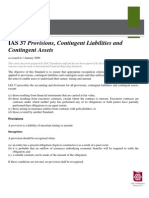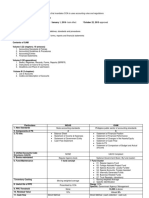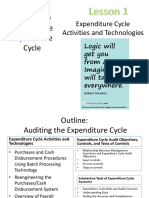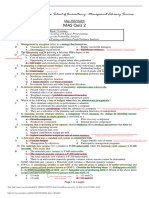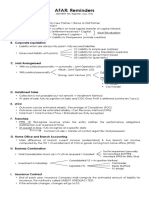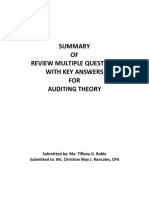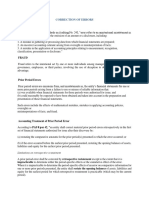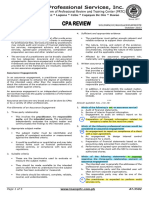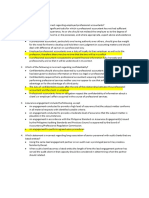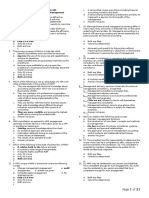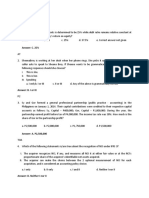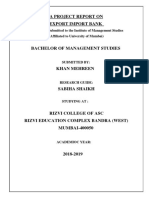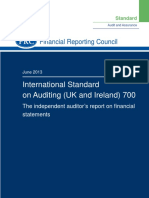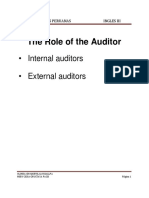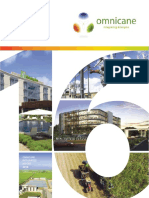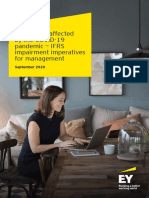Solutions For Chapter 1 Auditing: Integral To The Economy: Review Questions
Uploaded by
Stefany Mie MosendeSolutions For Chapter 1 Auditing: Integral To The Economy: Review Questions
Uploaded by
Stefany Mie MosendeSolutions for Chapter 1
Auditing: Integral to the Economy
Review Questions:
1-1. The special function performed by the public accounting profession is the attestation to
the fairness of the financial statements of clients. The special function ensures the
reliability and integrity of the financial reporting system. Judge Burger described the
special function as "certifying the public reports that collectively depict a corporation's
financial status," which involves "a public responsibility transcending any employment
relationship with the client."
The auditing profession exists to serve the users of an organization's financial statements.
These include lenders, investors, management, government, and (indirectly) all
individuals who are ultimately affected by the integrity of the financial reporting process.
1-2. The audit opinion formulation process is a systematic approach by which the auditor
evaluates the risk of being associated with a client, through the process of gathering and
evaluating audit evidence, to determining the type of audit opinion that should be
rendered. The stages and outcome of each stage are as follows:
Assessing Client Acceptance and Retention: The outcome is determining whether or not
a firm should serve a potential client. The decision will depend on the risk to the auditor
of being associated with a particular client.
Understanding the Client: The outcome is a business understanding of the client, its
major processes, the risks inherent in its business, and the impact of current economic
and competitive issues on the client.
Obtain Evidence About Controls: The outcome is an understanding of the client’s major
internal control practices and whether the controls are sufficient to mitigate the risk of
material misstatements in a company’s financial statements.
Obtain Substantive Evidence: The outcome is the audit evidence that is gathered,
evaluated, and synthesized to determine if the auditor has sufficient competent evidence
to render an audit opinion.
Wrap Up Procedures: A final review of evidence, as well as a review of the audit process
by someone outside of the audit to determine whether all procedures have been
performed and that audit risks have been evaluated. The final outcome is the decision on
which audit opinion to render.
1-3. The environment has changed in the following ways:
The U.S. audit standards are now set by a regulatory agency for public
companies.
The economy is more global, and thus auditors must understand international
audit standards.
The risks that affect the companies subject to audit have changed with greater
sensitivity to global issues.
The use of information technology continues to increase.
While the environment has changed, the expectations of users have stayed essentially
the same. They expect (a) auditors to detect and report on fraud, and (b) certify
financial statements that are both in accordance with GAAP and are transparent
regarding economic activities and conditions.
1-4. An audit service requires a report to a third-party user and thus requires independence on
the part of the attestor. Audit services differ from general assurance services in that
assurance services do not require a report to a third party. For example, a company may
request assurance services of their internal controls. At their request, the company may be
the only recipient of a report. Thus, the difference is related to whether or not the service
is provided to third parties. Further, an audit service is generally recognized as one that
pertains to an organization’s financial statements and internal controls over financial
reporting.
1-5. Auditors exercise professional judgment in virtually every aspect of the audit. That
judgment requires the auditor to exercise professional skepticism within a framework of
knowledge of the economics of a business and accounting knowledge. That judgment is
utilized in the following areas (but is not limited to these examples):
Evaluating the risk of being associated with a particular client,
Evaluating the risk associated with a client’s internal control process and the
potential implications regarding potential misstatements in accounting records,
Evaluating the economics of an organization’s financial transactions or the
economic value of an organization’s assets or liabilities,
Applying the proper accounting treatment to issues that arise during the conduct
of the audit.
1-6. Assurance services are needed because there is a:
Potential bias in providing information
Remoteness between a user and the organization or trading partner
Complexity of the transaction, information, or processing systems such that it is
difficult to determine their proper presentation without a review by an independent
expert
Need to minimize financial surprises
Interested parties need to have confidence that the information they are using to make
choices is reliable and not subjective. The public accounting profession has strict
independence rules and has traditionally been in a position of high trust with the investing
public, which gives them an important competitive advantage. The public accounting
profession also must have expertise in a variety of different kinds of business processes to
have the ability to deal with many types of transactions. The recent PCAOB requirements
call for auditors to comment on the appropriateness of accounting principles. This
requirement should reduce the number of financial surprises.
1-7. The primary reference points (criteria) to determine fairness of presentation are:
GAAP – generally accepted accounting principles determined by the FASB, the
GASB, or the IASB (International Accounting Standards Board).
COSO – Internal Control, Integrated Framework for reports on internal control over
financial reporting.
It is important to have criteria against which to judge fairness so that everyone is
communicating on the same page. Otherwise it becomes one’s opinion versus that of
someone else.
1-8. Complexity affects the demand for auditing services in that both users and management
need the expertise of professionals who understand the underlying economic substance of
transactions and financial instruments and, thus, who have the ability to determine the
appropriate accounting best to "fairly" portray the economic substance of an
organization's activities and financial condition.
The business environment in which the auditor must function is increasingly complex.
The major forms of complexity relate to:
a. Computer systems, which are becoming increasingly interdependent across
organizations.
b. Increased complexity of financial instruments and transactions entered into by
organizations.
c. The economic environment in which we all must operate. The changing
environment includes such items as the increased need to have a global outlook in
providing goods and services and the need to be attuned to societal regulations in
such areas as environmental protection.
1-9. There are two primary user interests in the reports on internal control over financial
reporting. They are:
Increased reliability of financial reporting, including both annual financial statements
and interim financial reports.
Increased stewardship on the part of management on the controls they have developed
to both protect and utilize the resources entrusted to them.
A review of the congressional deliberations when Sarbanes-Oxley was developed focused
on the need to restore investor confidence in the system. Most of the major frauds of the
late 1990’s and early 2000’s were perpetrated by management override of internal
controls.
1-10. All three of these parties are important users. Arguments can be made for each group as
follows:
Shareholders: They are owners of the organization and thus they represent the group to
which management is ultimately accountable (i.e., management serves only per the
wishes of shareholders). Owners as a group depend on an independent audit to inform
them of the stewardship and overall performance of management. Shareholders are also
represented through the Board of Directors whom they elect to represent their best
interests.
Creditors: They invest capital in the organization in the form of short-- or long--term
loans. Creditors are concerned with the safety of their loans and look to audited reports to
provide information on the status of the organization’s financial position and its earning
power to assess the relative safety of their loans or their decision to grant credit to an
organization.
Management: They are interested in seeing that the financial statements show their
performance, and if possible, to do so in a way that is most favorable to them. Many
members of management now have bonus (salary) agreements tied to reported profits.
Additionally, management may have stock options or stock investments that are
significantly affected by the reported profits of the company.
Of the three groups, management is more often quite short-term oriented in its
perspective (although certainly not all members of management fall into this group).
Often, management may be interested in achieving short--term objectives and in applying
accounting principles and judgments that are aggressive and seek to maximize reported
income. Creditors, on the other hand, are more concerned with the safety of their loans
and would prefer a conservative approach to accounting that might understate assets and
revenue and thus provide a cushion for safety. Investors are generally more long-term
oriented (although this is less true with the majority of stock ownership now residing in
mutual funds) and are generally more interested in the quality of reported earnings and
assets (i.e., they do not desire any over-- or under--statement; rather, they want the most
accurate information on which to make decisions).
The auditors resolve potential conflicts by:
Understanding the economic substance of transactions.
Determining how the economic substance guides the accounting choices.
Ensuring the accounting follows GAAP
Unbiased reporting implies that the auditor always favors appropriate accounting over the
desires of individual users.
1-11. The audit enhances the quality of financial statements because the user has the assurance
that an independent, qualified professional has examined the financial statements and has
rendered an opinion on their fairness. The independence and expertise of the auditor
serves as a quality control function to overcome the potential bias of management in
presenting the financial statements in a manner that most flatters an assessment of their
performance. The audit is designed to add credibility to the financial statements.
An audit does not necessarily ensure a fair presentation of a company's financial
statements although it does dramatically increase the likelihood that there are no material
misstatements in the company's financial statements. The caveats about fairness exist for
two reasons:
a. Fairness is judged within a framework of GAAP. Some question whether GAAP
result in the fairest possible presentations when there are significant changes in
market values of investments or assets. For example, the SEC has encouraged
financial institutions to move from using historical cost required by GAAP to market
values for all investments in securities because it believes that market value presents a
better picture of economic reality than does historical cost.
b. Although designed to detect fraud, it might be possible that a well-executed audit may
still fail to detect fraud.
In addition, an audit does not provide unequivocal assurance that the control systems are
free of material deficiencies, i.e., there is always “audit risk” even in a well-designed and
well-executed audit.
1.12. Corporate governance is an oversight structure that ensures that management operates in
the best interests of the shareholders and that there is appropriate accountability to the
organization’s stakeholders (owners, workers, regulators, lenders). Corporate governance
is important because it provides control to stakeholders; without it management would
not be held accountable for its actions. The audit committee improves corporate
governance because it acts on behalf of stakeholders, yet has inside knowledge of the
organization that those stakeholders cannot necessarily share.
1-13. Sarbanes-Oxley improved corporate governance in a number of ways besides the audit
committee requirements. Some of the other improvements include:
requires management ownership for the quality of the financial statements and
reports on internal controls. This ownership is presented in the form of separate
certification by management.
empowers the SEC to provide oversight over the setting of audit standards, and
through it, further guidance on such items as reporting on internal control, dealing
with materiality, and revenue recognition.
a public perspective in setting audit standards (PCAOB) that requires greater
skepticism of management.
1-14. Auditing services are a subset of assurance services. Specifically, auditing services
address assertions of management. More specifically, we tend to think of auditing
services as audits of a company’s financial statements in which management asserts that
the financial statements accurately portray the company’s financial results. However, as
indicated in the chapter, auditing services are not necessarily confined to financial
statements. Assurance services don’t necessarily evaluate assertions, but are aimed at
improving the quality of information for decision making.
Assurance services are needed because there is a:
Potential bias in providing information
Remoteness between a user and the organization or trading partner
Complexity of the transaction, information, or processing systems such that it is
difficult to determine their proper presentation without a review by an independent
expert
Need to minimize financial surprises
A market for assurance services already exists. CPAs have a monopoly on the assurance
on the quality of financial statements, and laws exist requiring an audit for any publicly
traded company. There is also an existing market for other assurance services, but CPAs
must continually attempt to gain market share as they do not hold a monopoly on those
services. In addition to gaining market share over their competition, CPAs can also
benefit from further developing a market for assurance services that can create value for
organizations.
1-15. The six areas identified by the Special Committee on Assurance Services that represent
the largest market potential for the next decade are:
Assisting organizations in identifying, measuring, assessing, and managing risks.
Providing assurance on information systems integrity.
Identifying and communicating improved methods of measuring and communicating
organizational performance.
ElderCare Services -- Improving the quality of financial services provided to the
elderly population.
Developing criteria and communicating assurance about the integrity and reliability of
transactions performed through electronic means.
Identifying better measurement techniques to quantify and communicate the quality of
health care services provided to a particular constituency.
1-16. The four primary attributes needed to perform assurance services are:
Subject matter knowledge: The assurance provider must have expertise in the area on
which assurance is provided. Knowledge of the area allows them to make accurate
judgments.
An independence from the parties requesting the assurance as well as the parties
benefiting from the assurance: The provider must be unbiased, objective, and
independent of the company or process being evaluated. Independence instills
confidence in the assurances provided.
Established criteria or standards regarding assurance subject: Having an agreed upon
set of standards against which to compare the subject matter allows assurance
providers to uniformly make judgments.
Expertise in the process of providing assurance: Assurance services are enhanced
when providers have a systematic process with which to gather and evaluate the
information or process.
These same attributes are also required for audits of a non-public company.
1-17. Internal auditing exists as a separate audit function within an organization with a
reporting responsibility to management, the board of directors, and the audit committee
of the board of directors. The scope of internal audits is generally much broader than that
of the external auditor. Internal auditing is viewed as an integral part of the organization’s
risk, governance, and control processes. The internal auditor often performs operational
audits, compliance audits, and computer system audits in addition to financial--type
audits. The internal auditing function must strive to achieve independence while working
within the organization. This is usually accomplished by reporting to a high management
level and the audit committee of the board of directors to ensure that no audit findings are
suppressed.
Persons are licensed as CPA's by state regulatory agencies. Only CPAs are licensed to
render an audit opinion. Internal auditors are not so licensed, but many internal auditors
are either Certified Internal Auditors or CPAs and adhere to the same level of standards,
as do the external auditors.
Public accounting firms perform internal audit work for clients, thus resulting in an
expansion of the type of audit work performed by many firms.
1-18. A public accounting firm that does not have any public clients is subject to the auditing
and ethical standards as promulgated by the AICPA; and is not subject to the standards
set by the PCAOB. An audit firm serving only non-public companies differs in the
following ways:
Can perform all types of attestation services, including compilations and reviews
(negative assurance and no assurance),
Can perform consulting activities for clients as long as they do not violate the AICPA
rules. For example, it can perform tax services for managers of their clients,
They are not required to perform audits of internal control over financial reporting,
Their audits can focus more on direct tests of account balances.
1-19. The GAO is the audit arm of the U.S. Congress with a broad mission to evaluate the
effectiveness, efficiency, and compliance of governmental agencies and other agencies
that are direct recipients of governmental funds.
Although the GAO performs all the types of audits performed by internal auditors, it
tends to perform more economy and efficiency audits because Congress is very
concerned with the manner in which the government carries out the various pieces of
legislation enacted by Congress. The scope of the GAO's audits is extremely broad. A
major part of the GAO's work is devoted to developing measurable criteria to compare
agency functions with legislative intent.
In setting standards for municipal audits, the GAO is responsible for issuing Government
Auditing Standards. The standards apply to "audits of government organizations,
programs, activities, and functions, and of government funds received by contractors,
nonprofit organizations, and other nongovernmental organizations . . . The standards
pertain to the auditor's professional qualifications, the quality of audit effort, and the
characteristics of professional and meaningful audit reports" (Foreword from the
Standards).
1-20. The Securities and Exchange Commission (SEC) has the power to dictate accounting
principles and to determine overall audit standards. This power to regulate the securities
industry in the aftermath of the Great Depression was given by Congress to the SEC in
1933 and 1934. It dictates the form of filings that must be made with it and that are
available as public documents for new issuances of debt or capital instruments.
Companies that meet minimum criteria for diversity of ownership must also file annual
and quarterly reports with the SEC. The SEC has traditionally worked with the
accounting profession to keep the standard--setting process in the private sector. A
representative of the SEC, for example, sits on the Emerging Issues Task Force of the
FASB. In addition to power to set standards, the SEC has the power to suspend parties
from practicing before it. Further, the SEC has the power to negate rules promulgated by
the PCAOB, and is certainly involved in a political capacity in shaping that
organization’s agenda.
1-21. The PCAOB:
a) Sets auditing standards for audits of public companies
b) Performs quality reviews of all firms that are registered with it.
c) All firms that audit public companies are required to register with the PCAOB
and are inspected by the PCAOB.
d) Does not set accounting standards, this is delegated to the FASB and the SEC.
The AICPA:
a) Does not set auditing standards for the audits of public firms anymore. They do
set standards for audits, reviews, and compilations of non-public companies.
b) Requires peer reviews of non-registered firms to assess the quality of their
audit practices.
c) Does not set accounting standards for public companies anymore.
1-22. COSO is the Committee of Sponsoring Organizations of the Treadway Commission. The
five sponsoring organizations include:
The American Accounting Association
The American Institute of CPAs
Financial Executives International
Institute of Internal Auditors
Institute of Management Accountants
Its major importance to the auditing profession stems from the almost universal adoption
of its framework, Internal Control, Integrated Framework that serves as the criteria by
which companies judge whether or not they have effective internal control. COSO has
also been active in developing new guidance for smaller business, as well as guidance for
the monitoring component of internal control.
1-23. For the most part, local CPA firms are subject to the same auditing and accounting
standards as the large international CPA firms. The differences relate to whether the audit
firms have (a) public clients, or (b) international clients. If a firm has public clients, then
the firm is subject to the standards of the PCAOB. If a firm has clients that are domiciled
in other countries, then they should utilize international auditing standards. If the audit
firm only has non-pubic clients, then they are subject to auditing standards promulgated
by the AICPA.
1-24. A network of accounting firms is a body to which individual CPA firms come together to
pursue common interests. The services generally provided by the network include:
centralized staff that provides accounting and auditing expertise to its members on a
world-wide basis,
a referral service for audit firms that have clients in different parts of the country or
world,
a referral service for a firm to utilize when clients desire expertise or consulting
services that the audit firm does not provide.
standard audit programs and/or procedure’s manuals for the member audit firms.
In some cases, the network can be a network of firms that are not otherwise affiliated. In
other cases, the network firms all operate under one common name, e.g. Grant Thornton
International.
1-25. In a primarily self-regulating profession, such as public accounting, there must be some
method to ensure that the profession is looking out for the best interests of the parties
whom it serves. The court system acts as a check and balance on the profession to ensure
that it does not ignore the needs of clients and third--party users and allow misleading
financial reports to be issued or the performance of substandard audits.
The court system does not directly set accounting or auditing standards. However, the
courts have been active in identifying situations in which they believe individual auditors
have been deficient. The identification of these deficiencies in court cases has often led
the profession to develop more detailed standards to guide practice. Examples of
standards that have evolved directly from the outcome of lawsuits include the standards
on subsequent events and related--party transactions.
Multiple Choice Questions:
1-26. c.
1-27. b.
1-28. a.
1-29. c. (assurance services don’t always require a third party)
1-30. d.
1-31. d.
1-32. d.
1-33. a.
1-34. d.
1-35. b.
1-36. b.
Discussion and Research Questions:
1-37. a. Neutrality is enhanced when each party uses the same reference point to determine
the fairness of an organization’s financial statements. If the reference is perceived as
being neutral, then the criterion helps the profession stay neutral. Generally accepted
accounting principles have been designed as standards that are neutral for users and
are applicable to general--purpose financial statements. GAAP are required for all
client financial statements that must be filed with the SEC. Some small companies
prepare financial statements on a tax or cash basis. In such instances, there must be
disclosure that such statements are on a comprehensive basis of accounting other than
GAAP.
One of the major objectives of the FASB Concepts Statements is neutrality. The
auditing profession adheres to the accounting standards universally recognized by
their general acceptance. Auditors present an independent, objective assessment of a
company's financial transactions and thus serve as a buffer to prevent management
from contriving transactions that will lead to a misleading presentation and thus favor
one group over another. (It must be admitted, however, that the independent auditor is
not always successful in achieving this latter objective. Usually a good class
discussion can be built around the auditor's responsibility for ensuring a fair
presentation and unbiased results.)
b. This question is intended to stimulate discussion on the part of students. It is difficult
to specify the most important users because a particular category of users may have
more interest in one particular set of financial statements. The users that students
should identify would include:
Investors: Existing shareholders, potential shareholders, and the financial community
as part of the investing public make up this group. Investors look to the financial
statements and the accompanying audit report to communicate the state of the
company's financial health and the performance of management.
An existing investor might prefer an accounting treatment that would enhance current
reported profit such as extending the depreciable life of assets.
Lenders: This group includes bank loan officers, bondholders, and vendors who
supply credit to the organization. Lenders are primarily interested in the safety of
their loans and look to the audited financial statements to provide information on
assets, profitability, and potential overextension of the company with too much debt
outstanding. Lenders generally prefer that the company take a conservative approach
to accounting. A lender would prefer that assets be depreciated over the shortest
possible life thereby encouraging more conservative balance sheet presentation of
assets.
Management and board of directors: Management is an important user because it
receives an objective overview of the quality of its internal accounting system.
Additionally, management needs objective, verifiable information on which to make
decisions affecting other users. The audit provides an independent analysis of the
financial reporting system and enhances the reliability of data affecting management
decisions. Management is often motivated to use accounting principles that boost
income because management bonuses are often tied with income.
Indirect users such as consumers: This group is not normally considered when
textbooks refer to important users. However, recent failures in the savings and loan
industry and related securities firms indicate that virtually no one remains untouched
when the integrity of the financial reporting process declines.
Indirect users are concerned about the accuracy of economic presentation of financial
results and current position. As noted earlier, the SEC, on behalf of these groups has
urged more current value accounting because of the agency's belief that such a
presentation better presents the true economic picture of the entity.
Governmental regulatory agencies: Governmental regulatory agencies at both the
state and federal level exist to protect various constituencies. The free flow of reliable
information is important to these agencies in identifying situations in which action
should be taken to protect other groups. For example, a state insurance commission
may review the financial reports o insurance companies reporting to them as a basis
to determine whether regulatory action is required to protect the investments of
various insurance policyholders. An agency's objectives dictate its views toward
accounting principles. Insurance commissions, for example, dictate a conservative
identification of admittable assets in filings with the state insurance commissions.
Most other agencies have similar objectives that dictate the form in which financial
statements are filed for regulatory purposes.
Labor and labor unions: Labor increasingly negotiates contracts with bonuses or
other payments contingent on the level of reported profitability of an employer.
Additionally, labor is interested in past profitability as a basis for negotiating current
wage levels.
1-38.
a. The value of the audit to external users, e.g. investors and creditors is the audit
provides an informed and unbiased report on the public company’s operations, its
internal controls.
b. An audit of internal controls provides value to the public in three ways:
it informs users of the accountability that management has assumed in
fulfilling its stewardship function,
it provides confidence in the company’s processes to control its
information and to provide reliable information on an interim basis, and
it helps ensure investors that management has reliable information on
which to makes its internal decisions.
c. An audit committee is important for the following reasons:
it provides oversight of the audit function on behalf of shareholders and
the board,
it is charged with the sole authority to engage the external auditor and
therefore the auditor is accountable to the audit committee rather than
management,
it helps ensure the independence and integrity of the audit process.
1-39.
a. The major objectives of an independent audit are to systematically acquire and
evaluate audit evidence to determine the fairness of a company's financial statements
(as judged by applicable criteria, such as GAAP) and to communicate that opinion to
interested users.
An audit may specifically benefit the auditee (Quello) in the following ways:
1. An independent assessment of the fairness of presentation enhances the
perceived reliability of the financial report and assists the company in
obtaining loans or new capital because the investing and lending public
will have confidence in the financial figures.
2. The auditor's expertise in related areas may help the client in
(a) Tax planning.
(b) Preparing tax returns.
(c) Selecting and implementing accounting information systems.
(d) Identifying sources of capital or loans.
(e) Preparing financial forecasts or analyses that may assist the company
in obtaining loans or new capital.
(f) Determining the efficiency of existing accounting operations.
(g) Observing areas in which efficiency and effectiveness of operations
might be improved.
3. The auditor's testing and evaluations of controls may provide insights into
areas in which improvements could be made.
4. The independent assessment and testing of transactions represent a
management control device because individuals know that their work will
be tested and evaluated.
5. The threat, as well as the performance, of an audit may act to deter
potential fraud.
6. The auditor's expertise may lead to improved financial presentations
because of the application of accounting principles or improved financial
statement disclosure.
7. The auditor's knowledge may lead to improved reporting for regulatory
purposes.
b. Some of the points that might be discussed by management in determining the nature
of the CPA firm to engage to conduct the audit:
1. The audit fees for conducting the audit.
2. The reputation of the auditor in the community and potential impact of auditor
reputation in securing loans or capital.
3. The ability of the auditor to assist the firm in expanding the scope of its
operations beyond the immediate geographic area.
4. The industry--specific knowledge of the potential auditors.
5. The individual personnel servicing the company, that is, the involvement of a
partner versus other personnel on the engagement.
6. Perceived audit expertise in ancillary areas such as tax, financial projections and
analysis, mergers and acquisitions, and systems.
7. The outcome of any recent peer review performed on the public accounting firm.
8. The satisfaction of other clients with the level of service obtained from the firm.
9. The need for national support staff for complex issues.
10. Plans by the company to issue stock.
11. The ability of the audit firm to use state-of-the art technology on the engagement
and to introduce that technology to the client.
(Note: The above list is not inclusive. Students are generally quite good in identifying
other factors that may or may not be important and thus provide for excellent
classroom discussion.)
c. The company is not required to have an audit committee. However, an audit
committee is recommended by the AICPA. Further, as the company plans to grow, it
will be important to establish all elements of effective internal control over financial
reporting. Thus, an audit committee will be valuable to the company if it considers
going public in the future.
d. Quello is not required to issue a report on the quality of its controls over financial
reporting. Such a requirement exists only for public companies. However, the
Company could engage the CPA firm to evaluate its internal controls as a basis for
improvement and future success.
1-40.
a. Most users agree with this statement. Therefore the auditing profession has expanded
its approaches to provide greater assurance that it will detect material fraud. However,
many misstatements that are made in conjunction with an organization's financial
statements are not intentional but are simply the result of errors. The audit function is
designed to detect material misstatements -- whether they are due to errors or fraud.
Thus, the audit function is actually broader than just looking for fraud. Ensuring that a
financial statement contains no material misstatements ensures that the auditor
addresses the likelihood that material errors and fraud may have occurred.
b. There is an independence problem, in some views, because the primary purpose of
the audit is to furnish financial statements to a bank or to another investor in order to
raise capital for the firm. Thus, the control of hiring and firing by the management is
seen by some as an impairment of the auditor’s independence. However, there is
really no one else to do the hiring in such cases.
c. Many people agree with this. The Red Cross owes accountability to its donors beyond
that which is conveyed in financial statements. The Red Cross has been criticized for
poor internal controls and poor and inefficient operations. Most donors have a vested
interest in understanding that their contributions have been used properly.
d. As time as passed, most observers have come to the conclusion that the expectations
are not too high. However, they do need some find tuning in relationship to how
much users want to pay for an audit.
e. Many practitioners believe this statement is true. However, there should be good class
discussion on this issue as it is germane to raise the question as to whether “if it is
good for non-public companies, why is it not good for public companies?” There are
various answers to this question, and many of them are dependent on the external
users of the company’s financial reports.
f. Many believe this statement is true. However, it has taken a while in order for the
PCAOB to get up to date on its inspection process. The PCAOB must prove itself in
setting standards that encourage and warrant the public trust.
g. GAAP represents rules and conventions that are acceptable at one point in time.
Much of the diversity in accounting principles is necessary to reflect real economic
differences between organizations and the types of transactions in which the
organization is engaged. Beyond this argument, differences such as LIFO / FIFO
accounting have evolved over the years. The profession attempts to mitigate the
potential problems associated with the diversity by providing disclosure of the
differences and by developing other procedures to make it difficult for firms to
change accounting principles. Thus, the financial statements of a company should be
comparable over a period of time.
h. This is true. Auditors need to provide clear guidance to the board, the audit
committee, and to management as to whether they believe the financial statements
best portray the economic events of the entity being audited.
i. This should generate good discussion. Most practitioners do not feel this constitutes a
problem. However, the PCAOB has provided guidance where auditors of public
companies cannot provide such tax services for executive management of their
clients.
1-41.
a. Areas in which audit judgment will be made, include, but are not limited to, the
following:
Evaluating the risk of being associated with a particular client,
Evaluating the risk associated with a client’s internal control process and the
potential implications regarding potential misstatements in accounting records,
Evaluating the economics of an organization’s financial transactions or the
economic value of an organization’s assets or liabilities, and
Applying the proper accounting treatment to issues that arise during the conduct
of the audit.
A quick review demonstrates that professional judgment is not at all limited to accounting
issues. A good auditor must understand the business, its transactions, its contracts, and
the economics of it transactions and contracts.
b. There is disagreement on whether principles-based accounting will lead to more or less
consistent judgments. Many believe that it will lead to less consistent accounting because
the rules are not as well specified. However, the alternative view is that accounting
judgments will become more consistent (especially on an international basis) because
auditors will need to take more time to understand and portray the economics of
transactions or the value of securities. The rationale for the accounting opinions must be
well reasoned and documented. This should also improve consistency. That said, it will
be a tremendous challenge for the public accounting firms to change the mindset to
accounting judgments and it will require a period of extensive review by concurring
partners.
c. It is very reasonable – especially from a user’s perspective – to expect that judgments
made by different auditors on different clients will be consistent. In other words, similar
economic situations should lead to similar accounting judgments. An audit firm’s
structure enhances the review and consistency of judgment in the following ways:
1) Continuing professional education on accounting issues,
2) Firm guidelines and pronouncements on accounting issues,
3) Review of significant accounting judgments by audit managers,
4) Further review by engagement partners,
5) Further review by concurring partners (a subject matter partner that is not
otherwise on the audit),
6) Internal inspections of the quality of audits by internal review teams.
1-42.
a. Understanding a business helps the auditor identify accounts that may be misstated.
This is particularly true when the misstatements may not be related to the actual
recording of transactions; but are due to changes in valuation that take place over
time. The auditor should understand:
competitive actions that could possibly make a product or service obsolete,
competitive effects on pricing,
changes in the economy or industry that could affect the collectability of
receivables,
use of products that may affect warranty claims,
whether current technology utilized by the firm is up to date,
changes made by competitors in their warranties.
This understanding can be applied to the listed accounts as follows:
Inventory: the auditor’s knowledge of competitor actions, the company’s product
placement in the market, current trends in consumer purchasing, and so forth, will
help the auditor determine if there is inventory that should be written down to a
market value that is lower than cost.
Allowance for Uncollectible Accounts: Changes in the economy may indicate that
certain parties are less likely to be able to pay. In 2007, there was a great fall-off in
sub-prime loans leading to greater loan loss reserves for many financial institutions,
and ultimately, the failure of some financial institutions.
Warranty Liability and warranty expenses: The market often dictates changes in
warranty policies. For example, General Motors increased its standard warranty from
36,000 miles to 100,000 miles on some products. The increase in warranty coverage
will likely be accompanied by an increase in warranty claims which should be
accrued for by the company.
b. The auditor brings a perspective to a privately-held company that is often broader
than that held by management. The auditor sees a number of different clients,
different industries, and differing strategies. The perspectives developed by the
auditor may provide insight to the client’s management that they otherwise would not
have.
1-43.
a. Assurances and Evidence
Assurance Tested Evidence to be Gathered to Test Assurance
All goods are shipped in a timely Take a sample of orders and trace to shipping
fashion. evidence, e.g. shipping documents, UPS documents,
or other evidence of shipment.
Take a sample of customer complaints or inquiries
and determine if there is a pattern of customers
complaining that goods are not received in a timely
fashion.
Goods are as advertised. Take a sample of advertisements and compare the
qualities advertised with a sample of products.
Company stands behind goods that are Take a sample of complaints or credit adjustment
damaged in transit. requests submitted by customers. Determine
whether or not the requests were handled
consistently with advertised company policy.
Company fulfills promises made in its Take a sample of credit sales. Determine that sales
credit policies. are billed according to company policy. Determine
Assurance Tested Evidence to be Gathered to Test Assurance
that interest, if applicable, is billed according to
company policy.
Credit card and billing information is Inquire of company policies designed to safeguard
kept safe and not sold to other customer information. Inquire of management as to
electronic retailers. (a) any sales of customer information; and (b)
policies and procedures in place to protect the
privacy of customer information. Review customer
complaints to determine if any relate to customer
privacy issues. Determine that company data are
protected. Attempt accesses to such data to
determine if unauthorized users can access such
data.
b. The assurances should be provided frequently enough to assure customers that the policies and
procedures continue to be effective, perhaps every three or six months.
c. The assurances should be evident on the company’s Web page with something like the UL or
good housekeeping seal. The seal could also be used on hardcopy promotional material.
d. The CPA has objectivity and integrity along with the skills needed to provide such assurances.
e. Old-line companies with a long history of good business practices probably do not need such
assurances.
f. Other potential providers include industry associations, Internet provider companies, Web
browser companies such as AOL, companies that provide e-commerce Web services, etc.
Alternatively, the companies may provide the assurances by promoting the quality of its
processes, soliciting testimonials from customers, and promoting a reputation of quality of
services.
1-44.
a. Internal auditing is defined as follows:
Internal auditing is an independent and objective assurance and consulting activity that
is designed to add value to improve an organization’s operations. It helps an
organization accomplish its objectives by bringing a systematic, disciplined approach
to evaluate and improve the effectiveness of risk management, control, and governance
processes.
It is defined as both an assurance and a consulting activity. Assurance is designed to
add value to an organization by providing management, the board of directors, and
operating management with independent analysis regarding company operations as
well as compliance with company policies and procedures. As companies enter into
more trading partner agreements, internal auditors may be called upon to provide
assurance on controls and operating procedures to the company’s trading partners.
Assurance services have been the historical base of internal auditing and will continue
to play a major role in the future development of the profession as the demand for an
increasing array of assurances continues to increase.
Consulting activities create an additional “value added” component to internal auditing.
Internal auditors are unique in that they see the breadth of corporate activities and can
provide insight into operations that few operational managers may have. Consulting
implies that auditors are willing to share recommendations on how to improve
operations. Additionally, auditors can serve on task forces to find ways to improve
operations. However, the final decision on actions to take and implementation still rests
with management.
b. The internal audit focus is on the risk management, control, and governance processes
in an organization. The role regarding risk management and control is as follows:
i. Determine whether the company has a systematic process to identify,
measure, control, or otherwise manage or take risks.
ii. Determine whether the company manages risks according to a company
approved risk policy.
iii. Determine whether the company has sufficient controls in place to identify
and manage risk.
iv. Determine if the controls are working properly.
Controls are integrally related to risk. Controls exist to assist the organization in
identifying, mitigating, or preventing undue risks. The auditor’s role is to determine
that proper controls are implemented and are operating effectively.
An internal auditor also uses risk to identify areas for audit review. The auditor should
work with management to systematically identify risk and consult with management
and the audit committee to identify the risk areas that should be reviewed by the audit
function each year.
c. Internal auditing is a good career alternative to a career in public accounting. Some of
the reasons for pursuing a career in internal auditing include:
1. Internal auditing is a broad discipline. An internal audit department will be
composed of individuals with a wide variety of industry and company
experience.
2. Internal auditing is one of the fastest growth areas of public accounting
firms. Most of the large public accounting firms, as well as other firms, are
developing strong practices in outsourcing the internal audit function.
3. An internal auditor has the opportunity to develop a keen understanding of
all aspects of a business by rotating audits through various areas. The
auditor's knowledge obtained in one operational audit can usually be
transferred to other operational audits.
Internal auditing presents an excellent training ground for future management
positions. The internal auditor performing operational auditing is developing a
broad perspective of the organization that provides excellent background for
promoting the auditor into management positions.
The internal auditing department is becoming increasingly professionalized with
the Certified Internal Auditor (CIA) certificate becoming recognized on a global
basis as a standard of competence and excellence in internal auditing.
d. Public accounting firms are moving to perform internal audit work on an outsourcing
basis (sometimes referred to as “extended audit work”.) The public accounting firms
argue that they can provide the same quality of work more efficiently, in many cases,
because they can bring experienced personnel with a fresh view to the audit. They can
also bring wide industry expertise and technology that often is not available within the
internal audit department. Outsourced internal audit work appears to be a major growth
field for the public accounting profession.
1-45.
a. The American Institute of CPAs (AICPA) is a body representing CPAs that has
lessened in its power. No longer having the power to oversee the audits of public
companies, it still has a number of senior committees that develop auditing standards,
study and develop interpretations of preferred accounting for complex transactions,
discipline members for violation of the profession's Code of Professional Conduct,
monitor the quality of the practice of public accounting through two practice
divisions, and work to establish reasonable boundaries on new areas of services to be
performed by public accounting firms and CPAs.
b. The Institute of Internal Auditors (IIA) is a worldwide professional organization of
internal auditors. Like the AICPA, the IIA works to enhance the professionalism of
internal auditing and has issued standards for the practice of internal auditing and a
code of ethics and has developed a certification program, the Certified Internal
Auditor (CIA), to identify a standard of excellence for the professional practice of
internal auditing. CIAs must adhere to the profession's standards and must meet
continuing education requirements. However, unlike the CPA certificate, the CIA
certificate is not a licensing requirement for individuals to practice.
c. The Governmental Accountability Office (GAO) is the audit function of the U.S.
Congress. In addition to performing audits, it is responsible for developing standards
for auditing governmental units. The standards promulgated by the GAO are
applicable to the conduct of governmental audit work in the United States. Most
governmental regulations, particularly grant programs, require audits to be conducted
in accordance with governmental audit standards. CPA firms or internal auditors
performing governmental audits in conjunction with grants or other governmental
programs must adhere to the governmental auditing standards.
d. The Securities and Exchange Commission (SEC) is the primary governmental
agency with the responsibility to regulate the securities market in the United States.
One major part of its activity is to ensure a free and accurate flow of reliable financial
information. Within the purview of these general powers, the SEC has the power to
dictate accounting principles for companies that must report to it and has the ability to
specify information that must be included in both annual reports and periodic reports
that must be filed. The SEC also has the ability to censure firms practicing before it
and in some instances, may also bar firms from practicing before it. The SEC also
issues Accounting Series Releases in response to problems it has identified and
specifies appropriate accounting to address them. The SEC has become more activist
in the past two decades and has shown an increasing willingness to react to what it
believes to be substandard reporting by specifying reporting improvements.
e. The Public Company Accounting Oversight Board (PCAOB) is a quasi-public
board appointed by the SEC as part of the Sarbanes-Oxley Act of 2002 to provide
oversight of the firms that audit public companies that are registered with the SEC. It
has the authority to set auditing standards for the audits of public companies. In
addition, all CPA firms that audit public companies are required to register with it,
and the PCAOB performs quality reviews of each of these firms. The board has the
power to prohibit a firm from performing audits on public companies, should such an
extreme case arise.
f. The International Auditing and Assurance Standards Board (IAASB). The
IAASB sets the standards for auditing public companies on a global basis. The
standard setting reflects the many constituents of the board. The movement towards
convergence of the PCAOB and the IAASB is not nearly as fast as that of the FASB
and the IASB.
1-46.
a. A career starting within internal auditing would most likely differ from a career
starting in public accounting in the following ways:
1. The internal auditor would audit a number of different functions within one
organization rather than audit the same type of function within a larger number of
organizations. If the organization is large and diverse, the internal auditor will
likely have very wide experiences across both functional areas and industry types.
2. The internal auditor will most likely perform operational audits rather than, or in
addition to, financial audits and will be looking for potential recommendations to
improve the operations of the organization.
3. The internal auditor would develop expertise in risk management and controls,
including controls designed to evaluate the efficiency of operations.
4. The internal auditor will pursue certification as a Certified Internal Auditor to
exhibit professional competence in the area of internal auditing. Many individuals
will also sit for the CPA exam to enhance their professional recognition and to
obtain recognition that they may perform some financial audit work in connection
with the annual audit of the company.
b. Internal auditing provides an excellent starting point for a career in management
because the internal auditor is in a position to understand all aspects of an
organization and how it comes together to accomplish its objectives. By
performing operational audits, the internal auditor learns about the "best" kind of
procedures to accomplish organizational objectives and then compares actual
company performance with the "best' types of procedures. The auditor is always
looking for constructive ways in which organizational objectives can be
performed more efficiently or where cost savings can be realized. Finally, the new
internal auditor can make a strong impression with existing management by
demonstrating insight on the effectiveness of operations. To be successful, the
internal auditor must learn how to deal with people who do not necessarily want
to be reviewed and then convince them that the auditor's recommendations can
help them accomplish their own task. Much of management involves working
with people, and internal auditors find out about the importance this very early in
their career. It is not a desk job!
1-47.
1. Auditing does not involve the creation of goods. However, it does serve a worthwhile
purpose in our society because it enhances the flow of reliable financial information
needed to conduct commerce in our economy. It also assists in the conduct of
government by providing reliable information for tax purposes and regulatory
purposes. Audits have been legally mandated to ensure objective information.
However, research has indicated that audits would be required even if not mandated.
The initial audits performed in conjunction with the settlement of the new world arose
because of owners' need to have an independent assessment of the returns earned by
their managers.
2. The accounting profession did provide early warning signals of the potential
problems within many industries. However, it clearly failed in other areas. Some of
the problems were related to the impreciseness of accounting principles (e.g. Enron)
while others were more closely related to regulatory failures (e.g. Savings & Loan
Industry). However, many of the failures were due to systematic problems in the
accounting profession that has been addressed by Sarbanes-Oxley.
3. Finding fraud may be important. However, many misstatements that are made in
conjunction with an organization's financial statements are not intentional but are
simply the result of errors. The audit function is designed to detect material
misstatements -- whether they are due to errors or fraud. Thus, the audit function is
actually broader than the colleague had desired. Ensuring that a financial statement
contains no material misstatements also ensures that the auditor addresses the
likelihood that material fraud may also have occurred. As we will see later, SAS 99
has increased the auditor’s responsibility to search for fraud.
4. There is a potential problem with the auditors being hired by management. The
Sarbanes-Oxley Act requires companies that are publicly traded to have an audit
committee composed of independent directors (nonmembers of management) that
have the responsibility for evaluating the performance of the auditors. The audit
committee should exist to present the views and interests of outside owners of the
organization and provide effective insulation against undue pressure by management
on the audit function. The SEC is very cognizant of independence issues and
periodically addresses actions or relationships that they believe may impair the
auditor’s independence.
5. Most observers believe this statement is true. However, the PCAOB must prove itself
in setting standards that engenders the public trust.
6. GAAP represents rules and conventions that are acceptable at one point in time.
Much of the diversity in accounting principles is necessary to reflect real economic
differences between organizations and the types of transactions in which the
organization is engaged. Beyond this argument, differences such as LIFO / FIFO
accounting have evolved over the years. The profession attempts to mitigate the
potential problems associated with the diversity by providing disclosure of the
differences and by developing other procedures to make it difficult for firms to
change accounting principles. Thus, the financial statements of a company should be
comparable over a period of time.
7. It seems that this individual really wants to have a career in auditing. External
auditing has changed; in today's environment, the auditor must thoroughly understand
a company's business in order to audit it. A key function of internal auditors is to add
value through their recommendations.
8. The external audit is designed to present an opinion on the fairness of a company’s
financial statement in accordance with GAAP. It is not directly designed to assess the
performance of management, although the financial statements may provide some
evidence on the performance of management.
9. Auditors operate in an environment in which they must have a sense of trust with
management – at least to the extent that confidential or proprietary information is not
made public. Thus, if all recommendations made to management were to be made
public, management might simply ask that recommendations no longer be made.
Further, it must be recognized that many of the recommendations made to improve
operations are informal in nature and might not be based on thorough study of a
particular area. Auditors may justifiably fear litigation from recommendations made
public that were made only on informal observations.
10. Congress, in developing the Sarbanes-Oxley Act believes this statement is true.
Maintaining adequate controls is a significant part of corporate governance. Congress
believes the owner (shareholder) should receive reports on the quality of controls
implemented by management. In the first three years of public reports on internal
control, there has been a dramatic change in the quality of controls in many
organizations. During the first year of Sarbanes-Oxley, approximately 16% of the
companies received adverse reports on the quality of their internal controls. This
percentage has gone down dramatically.
1-48.
A. An operational audit of the indicated areas would address the following:
1. Treasury function. The auditor would attempt to determine the policies and
procedures in place to ensure that funds are handled in a manner to meet the
organization's needs and maximize its return. The auditor would attempt to
determine the "best" type of practices as indicated by good finance theory as a
basis for understanding the efficiency with which the treasury function carries
out its activities.
2. Inventory management and control. Similar to the discussion of the treasury
function above, the auditor consults textbooks or other sources to understand
the types of procedures that have been developed to accomplish efficient
management and control of inventory. These "best" procedures will be
compared with the procedures actually utilized by the company. The auditor
also attempts to understand and evaluate the effectiveness with which current
policies and procedures are implemented to determine whether cost problems
are associated with current approaches.
3. Customer service. Most organizations have objectives as to customer service
including the timeliness of response, the satisfaction of customers with the
response, and the cost of delivering the services. The auditor gathers evidence
related to these objectives.
B. An operational audit performed by an internal audit department focuses on the
nature of the operations and how they might be improved. However, the audit is
simply about improvement. The auditor evaluates the operational area in relation
to relevant criteria, whether that criterion is based on company policies or best
practices in industry. The process of gathering and evaluating evidence will be
similar, but the evidence gathered will be related to operational analysis rather
than financial statement presentations.
1-49.
a. There seems to be a misinterpretation on the part of many users that a "clean" audit
opinion means that the company is in good health. This, unfortunately, is a
miscommunication. A "clean" audit opinion means only that the financial statements
are fairly presented, not that they represent a company that is in good financial health.
The audit function provides data that are "fairly presented" in accordance with GAAP,
but such information alone does not constitute all the information an informed user
should know about a company.
b. The auditor is a guarantor only of following generally accepted auditing standards in
determining whether the statements are fairly presented, in all material respects, in
accordance with generally accepted accounting principles. Fair presentation is
guaranteed only within the context of GAAP.
c. This question and should encourage a widely ranging discussion by users. Topics that
might be addressed include these:
1. The potential deficiencies in GAAP.
2. The ability to detect fraud when management has attempted to cover it up.
3. The responsibilities of users to perform their own work and to not expect
someone else to make decisions for them.
4. The overall responsibility of management for the integrity of the financial
statements.
5. The value of reports on internal control.
6. The difficulty of measuring the economics of complex transactions.
1-50.
a. The five members will vary depending on the time period. While the five members all
have significant experience in business and often financial affairs, no more than two
of the five members are CPAs.
b. This exercise is designed to exhibit the constantly evolving nature of accounting
standards, as well as provide the student with the experience of understanding new
accounting standards. Additionally, these exercises provide the student with more
experience in navigating official websites.
1-51.
The purpose of this exercise is to exhibit the numerous cases brought by the SEC each
day, as well as to provide the student with practice in understanding and analyzing the
cases.
1-52.
The purpose of this exercise is to exhibit the constantly evolving nature of professional
accounting guidance that is provided by the SEC.
1-53.
This exercise is designed to exhibit the different goals of public company audit firms and
those that audit non-public companies. Typically the smaller firms that audit non-public
clients have a motto such as “Your most trusted business advisor” which designates them
as more of a business partner serving management than a party meant to serve the public.
In this role, the non-public audit firms usually perform a number of services other than
just an audit, and profitability of their client is a major goal as much if not more so than
to serve the public.
Cases:
1-54. a. The GAO would first review operational policies and guidelines by the EPA and then
examine actual staffing to determine areas in which the EPA has concentrated its
activities. The GAO will also develop information on accomplishments of the agency
and compare performance in one area with another. Lack of accomplishments in cost
recovery, as well as lack of personnel assigned to the cost recovery function, would
indicate a low priority assigned by the agency.
b. Long-term, measurable goals are necessary to establish a benchmark against which
progress can be evaluated. Without measurable goals, it is extremely difficult to
determine whether a governmental agency is accomplishing the mission planned
when legislation was enacted by the Congress. Much of the frustration of the GAO in
performing its audits relates to the identification of such goals.
c. Yes, the GAO report described represents an audit that could be viewed as a
combination of an operational audit and a compliance audit.
d. The GAO determines identifiable criteria against which to measure operations,
interpret legislative intent, and determine the extent to which the agency is
accomplishing legislative objectives. The GAO audit work focuses much more on
operational audit and compliance audits whereas the public accounting profession
focuses on a much narrower objective in auditing the fairness of a company's
financial statements.
You might also like
- MGT101 Study Material (Module 01 To Module 18)100% (2)MGT101 Study Material (Module 01 To Module 18)366 pages
- IAS 24 Related Party Disclosures: All Financial StatementsNo ratings yetIAS 24 Related Party Disclosures: All Financial Statements11 pages
- Session 3 AUDITING AND ASSURANCE PRINCIPLESNo ratings yetSession 3 AUDITING AND ASSURANCE PRINCIPLES29 pages
- Chapter 10 Identifying and Assessing The Risks of Material MisstatementsNo ratings yetChapter 10 Identifying and Assessing The Risks of Material Misstatements7 pages
- Auditing and Assurance: Specialized Industries - Midterm Examination100% (1)Auditing and Assurance: Specialized Industries - Midterm Examination14 pages
- Lesson H - 1 Ch10 Exp. Cycle Act. Tech.No ratings yetLesson H - 1 Ch10 Exp. Cycle Act. Tech.57 pages
- Module 2 For Elective 3 - Operations Auditing100% (1)Module 2 For Elective 3 - Operations Auditing21 pages
- Advanced Financial Accounting and ReportingNo ratings yetAdvanced Financial Accounting and Reporting2 pages
- Gelinas-Dull 8e Chapter 11 Billing & Receivable100% (1)Gelinas-Dull 8e Chapter 11 Billing & Receivable30 pages
- OF Review Multiple Questions With Key Answers FOR Auditing TheoryNo ratings yetOF Review Multiple Questions With Key Answers FOR Auditing Theory68 pages
- Review Materials: Prepared By: Junior Philippine Institute of Accountants UC-Banilad Chapter F.Y. 2019-2020No ratings yetReview Materials: Prepared By: Junior Philippine Institute of Accountants UC-Banilad Chapter F.Y. 2019-202033 pages
- AT.3502 - Introduction To Audit and Other Assurance ServicesNo ratings yetAT.3502 - Introduction To Audit and Other Assurance Services5 pages
- Chapter 8 Consideration of Internal Control in An Informati100% (1)Chapter 8 Consideration of Internal Control in An Informati32 pages
- Module 9 Reports On Audited Financial StatementsNo ratings yetModule 9 Reports On Audited Financial Statements53 pages
- Lesson Number: 01 Topic: Fundamentals of Assurance Services Learning ObjectivesNo ratings yetLesson Number: 01 Topic: Fundamentals of Assurance Services Learning Objectives19 pages
- Legal and Ethical Issues For It Auditors - QuestionsNo ratings yetLegal and Ethical Issues For It Auditors - Questions3 pages
- Chapter 7 Auditing in A Computerized EnvironmentNo ratings yetChapter 7 Auditing in A Computerized Environment25 pages
- Unit Iv Assessment Part I Internal Control A Tool in Managing RiskNo ratings yetUnit Iv Assessment Part I Internal Control A Tool in Managing Risk7 pages
- Solution Manual For Auditing A Business Risk Approach 8th Edition by Rittenburg Complete Downloadable File at100% (1)Solution Manual For Auditing A Business Risk Approach 8th Edition by Rittenburg Complete Downloadable File at35 pages
- Summer Training Report Textile IndustryNo ratings yetSummer Training Report Textile Industry80 pages
- International Standard On Auditing (UK and Ireland) 700: Financial Reporting CouncilNo ratings yetInternational Standard On Auditing (UK and Ireland) 700: Financial Reporting Council23 pages
- How To Get Started With An Authorization Concept - Cloud - V1No ratings yetHow To Get Started With An Authorization Concept - Cloud - V136 pages
- Financial Statement Analysis at Heritage FoodsNo ratings yetFinancial Statement Analysis at Heritage Foods83 pages
- Prospectus - Good Information On Assets PDFNo ratings yetProspectus - Good Information On Assets PDF280 pages
- Generally Accepted Accounting PrinciplesNo ratings yetGenerally Accepted Accounting Principles3 pages
- Financial Statement Analysis: Standard Course OutlineNo ratings yetFinancial Statement Analysis: Standard Course Outline6 pages
- Masters - Audit 1 Questions & SolutionsNo ratings yetMasters - Audit 1 Questions & Solutions30 pages
- Ey Covid 19 Ifrs Impairment Imperatives For ManagementNo ratings yetEy Covid 19 Ifrs Impairment Imperatives For Management13 pages
- Auditing & Assurance Services: A Systematic Approach 10th Edition William Messier JR - Ebook PDF Download PDF100% (12)Auditing & Assurance Services: A Systematic Approach 10th Edition William Messier JR - Ebook PDF Download PDF59 pages
- A.2.5. Letter of Confirmation of The EngagementNo ratings yetA.2.5. Letter of Confirmation of The Engagement3 pages
- Analyzing Investing Activities:: Special TopicsNo ratings yetAnalyzing Investing Activities:: Special Topics40 pages
- IAS 24 Related Party Disclosures: All Financial StatementsIAS 24 Related Party Disclosures: All Financial Statements
- Chapter 10 Identifying and Assessing The Risks of Material MisstatementsChapter 10 Identifying and Assessing The Risks of Material Misstatements
- Auditing and Assurance: Specialized Industries - Midterm ExaminationAuditing and Assurance: Specialized Industries - Midterm Examination
- OF Review Multiple Questions With Key Answers FOR Auditing TheoryOF Review Multiple Questions With Key Answers FOR Auditing Theory
- Review Materials: Prepared By: Junior Philippine Institute of Accountants UC-Banilad Chapter F.Y. 2019-2020Review Materials: Prepared By: Junior Philippine Institute of Accountants UC-Banilad Chapter F.Y. 2019-2020
- AT.3502 - Introduction To Audit and Other Assurance ServicesAT.3502 - Introduction To Audit and Other Assurance Services
- Chapter 8 Consideration of Internal Control in An InformatiChapter 8 Consideration of Internal Control in An Informati
- Lesson Number: 01 Topic: Fundamentals of Assurance Services Learning ObjectivesLesson Number: 01 Topic: Fundamentals of Assurance Services Learning Objectives
- Legal and Ethical Issues For It Auditors - QuestionsLegal and Ethical Issues For It Auditors - Questions
- Unit Iv Assessment Part I Internal Control A Tool in Managing RiskUnit Iv Assessment Part I Internal Control A Tool in Managing Risk
- Solution Manual For Auditing A Business Risk Approach 8th Edition by Rittenburg Complete Downloadable File atSolution Manual For Auditing A Business Risk Approach 8th Edition by Rittenburg Complete Downloadable File at
- International Standard On Auditing (UK and Ireland) 700: Financial Reporting CouncilInternational Standard On Auditing (UK and Ireland) 700: Financial Reporting Council
- How To Get Started With An Authorization Concept - Cloud - V1How To Get Started With An Authorization Concept - Cloud - V1
- Financial Statement Analysis: Standard Course OutlineFinancial Statement Analysis: Standard Course Outline
- Ey Covid 19 Ifrs Impairment Imperatives For ManagementEy Covid 19 Ifrs Impairment Imperatives For Management
- Auditing & Assurance Services: A Systematic Approach 10th Edition William Messier JR - Ebook PDF Download PDFAuditing & Assurance Services: A Systematic Approach 10th Edition William Messier JR - Ebook PDF Download PDF









